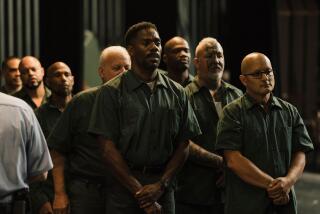STAGE REVIEW : STOP-GAP’S ‘MENAGERIE’ IS INCISIVE
Stop-Gap Theatre’s production of “The Glass Menagerie” does not have an auspicious beginning.
Gary Bell, playing the dreamer Tom, delivers the opening soliloquy in a moody baritone, his face pinched with drama. It’s an overbearing approach that seems to say “Hey, this is Tennessee Williams; this is classic stuff, pay attention!” It seems to promise a self-consciously grim production intent on driving home “Menagerie’s” emotional messages.
Fortunately, the anxiety is fleeting. Director Don R. Laffoon has engineered a delicate and touching revival that, while often suffering from Williams’ usual joining of beauty and bathos, is almost always satisfying.
Perhaps more than anything, this production at Brea’s Curtis Performing Arts Center shows what a king-size play “The Glass Menagerie” is and what a unique playwright Williams was.
One of his earliest full-length works (1945) and thought to be autobiographical, “Menagerie” is ripe with heartache: it’s tone is resolutely blue, and there’s not much humor or irony to balance the load. The saving strength, however, is its incisive portrait of a fragile family breaking under the weight of its own isolation.
Williams reveals the Wingfield clan’s frustration primarily through Tom, the poet who yearns for the open road but who is tied to his mother, Amanda (played by Marnie Crossen), and handicapped sister, Laura (played by Victoria Ann-Lewis). He’s their sole support, but more than that, Tom is the link to the outside world. The mystery of his midnight ramblings in town, while infuriating to Amanda, is a hint of the rich life that exists beyond their cloistered home.
Amanda, an aging Southern belle who refuses to fade, is a domineering force; sad and regal, she wants the best for her children but is equally frightened to lose them. She doesn’t have to fret about Laura, though, a waif who wraps herself in a cocoon of shyness, her only pleasures derived from the Victrola and a zoo of tiny crystal figures she lavishes with attention. Laura’s introverted world is disturbed when a juicy, bantering friend of Tom drops by for dinner.
Laura undoubtedly inspires the most sympathy in the audience, and her loneliness is the easiest symbol of the family’s retreat, but it is clear that “Menagerie” is really Tom’s story. His need to fulfill himself by leaving is what sets the tension. And when he finally abandons Amanda and Laura, Williams’ credo that art is paramount (more important even than loved ones) is realized.
Bell understands Tom’s conflict and is effective in portraying both the responsible son and the hungry writer eager to be on his own. As in the opening and closing monologues, he trips over the character’s self-importance every now and then but is still able to make Tom someone we can root for.
In a role that too often is over-played, Ann-Lewis is appropriately restrained as Laura. She effortlessly communicates Laura’s conscious separation from life. She appears sometimes like a wan specter--there, but not really there. The quality of impermanence she conveys is a credit to her performance.
There’s nothing tenuous about Crossen’s Amanda. The characterization is vivid and riveting, but unfortunately the interpretation seems off. Amanda veers away from harmless neuroses toward downright psychosis at times, often resembling an older, matronly version of Blanche DuBois. It’s not a new reading of the role--even Katharine Hepburn gave Amanda a dangerously unstable edge--but it does seem extreme here.
Margaret Perry’s set, which conveys the Wingfield living room and dining area, is simple and graceful, but one inspiration does go awry. Immense photos of city scenes (streets, train yards, warehouses) are projected on the back wall throughout the play. While the intent is evocative, the effect is confusing and distracting.
“THE GLASS MENAGERIE” A Stop-Gap production of Tennessee Williams’ “The Glass Menagerie” at the Curtis Performing Arts Center in Brea. Director: Don R. Laffoon. Principal Cast: Gary Bell, Marnie Crossen, Victoria Ann-Lewis and Thomas Maguire. Set design: Margaret Perry. Light design: Terri Gens. Sound design: Michael Silversher. Plays at 8 p.m. May 1, 2, 7, 8 and 9; and at 2:30 p.m. May 2 and 9. Tickets are $10, $8 for students and seniors. 1 Civic Center Circle, Brea. (714) 722-7727.
More to Read
The biggest entertainment stories
Get our big stories about Hollywood, film, television, music, arts, culture and more right in your inbox as soon as they publish.
You may occasionally receive promotional content from the Los Angeles Times.










